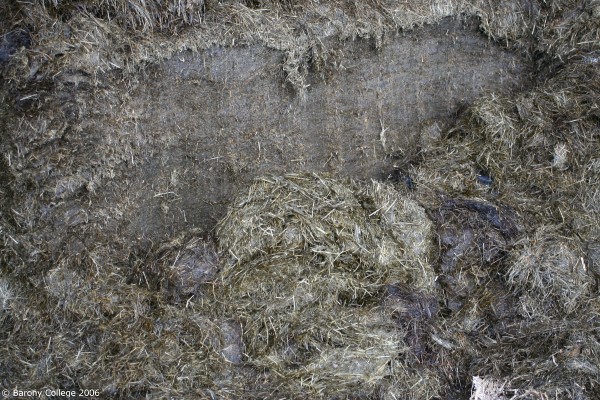High Dry Matter Silages for Suckler Cows
26 November 2021Analysis of this year’s beef and sheep silages through SRUC’s Analytical Laboratory show some very high dry matter silages, particularly for bales, and these can bring some challenges for managing keeping quality, mycotoxin risk and the effect on intakes and forage budgets. From the table below, some silages tested as high as 70% dry matter!
| Nutrient | Average of all silages (range in brackets) | 1st Cut Pit | 2nd Cut Pit | 1st Cut Bales | 2nd Cut Bales |
|---|---|---|---|---|---|
| Dry matter g/kg | 350 (142 - 700) | 311 | 305 | 389 | 352 |
| ME MJ/kg DM | 10.7 (8 - 12.3) | 11 | 10.8 | 10.5 | 10.6 |
| Crude protein g/kg DM | 113 (51 -226) | 109 | 126 | 108 | 124 |
| NDF g/kg DM | 495 (337 - 647) | 491 | 467 | 512 | 470 |
| Sugar g/kg DM | 79 (30 - 109) | 74 | 69 | 84 | 85 |
Lower Intakes And Forage Budgets
The risk with higher dry matter silages is that recommended intakes may not be achieved, meaning that cows could fail to meet their energy requirements. Many suckler cows will tend to be on restricted silage-based diets with straw to limit energy intake and condition gain pre-calving and so the risk of low forage intakes with high dry matter silages are not necessarily an issue. However, closer to calving cows carrying twins are more likely to be affected, where their energy requirements are at least 20-25 MJ greater than cows carrying a single calf, equivalent to an extra 5 kg of a 40% dry matter silage at 11 ME required, or 2 kg of barley.
Post-calving, if high silage dry matter is impacting on intakes, the risks are that cows will lose condition, milking off their backs to support milk production and may take longer to get back in calf as a result of excessive weight loss. This is where careful attention to feeding is necessary to ensure cows are eating the correct amount of silage they are rationed for and if not, feedback to your nutritionist so that the diet can be altered, with concentrate added if necessary to meet requirements.
The dry matter of silage has a significant effect on the amount of fresh weight to be fed. A spring-calving cow is typically fed around 1.5% bodyweight before calving, so for a 700 kg cow, that is equivalent to 10.5 kg of dry matter. With a 25% dry matter silage, this requires a fresh weight intake of 42 kg, but with a 40% dry matter silage that equates to only 26 kg of silage fresh weight.
When budgeting for silage bales, a 700 kg bale at 25% dry matter will feed 16 suckler cows per day but a 700 kg bale at 40% dry matter will feed 26 suckler cows per day. However, this will vary depending on quality, with lower ME and higher NDF silages having lower predicted intakes.
Pit Management
High dry matter silages are more prone to spoilage on the clamp face and so good clamp management is essential. Aim to move across the clamp face as quickly as possible, ideally within three days, taking half depth blocks if necessary. Use a block cutter to keep the face as clean as possible and reduce air ingress, minimising the risk of secondary fermentation. Any obvious areas of mould should be discarded and the same goes when feeding out bales, due to the risk of abortion.
Mycotoxins
With high dry matter silages there can be an increased risk of mycotoxins, due to moulds forming as a result of the higher pH and the silage being less stable. Silages with a pH of 4.3 or less are thought to be fairly stable and are less likely to encourage growth of mycotoxin producing moulds. It should be noted that mycotoxins can be present even if there are not obvious signs of mould and their effects can be additive if several mycotoxins are present in feeds.
They can have major effects on rumen microbes, reducing feed digestibility, leading to reduce milk yield, poor dry matter intakes and scour from inflammation of the digestive tract. Other effects include immune suppression, with cows more susceptible to diseases including mastitis and metritis. Aspergillus fumigatus is a common mycotoxin producing mould found on conserved forages and can cause pneumonia as well as mastitis and abortions. Other mycotoxin symptoms include effects on fertility, with poor conception rates, cystic ovaries, embryo loss and abortion.
If mycotoxins are suspected, the feed can be tested, and various products are available to help combat their effects.
Lorna MacPherson, lorna.macpherson@sac.co.uk
Sign up to the FAS newsletter
Receive updates on news, events and publications from Scotland’s Farm Advisory Service

